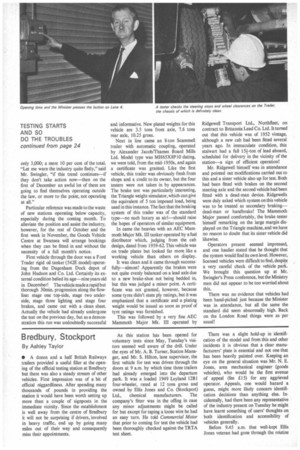TESTING STARTS AND SO DO THE TROUBLES continued from page
Page 28

If you've noticed an error in this article please click here to report it so we can fix it.
24 only 3,000; a mere 10 per cent of the total. "Let me warn the industry quite flatly," said Mr. Swingler. "if this trend continues—if they don't take action now—then on the first of December an awful lot of them are going to find themselves operating outside the law, or more to the point, not operating at all."
Particular reference was made to the waste of new stations operating below capacity, especially during the coming month. To alleviate the position and assist the industry, however, for the rest of October and the first week in November, the Goods Vehicle Centre at Swansea will arrange bookings when they can be fitted in and without the necessity of a full month's notice.
First vehicle through the door was a Ford Trader rigid oil tanker (542E model) operating from the Dagenham Dock depot of John Hudson and Co. Ltd. Certainly its external condition belied its age—nine years old in December! The vehicle made a rapid but thorough 30min. progression along the flowline: stage one top-side, stage two underside, stage three lighting and stage four brakes, and came out with a clean sheet. Actually the vehicle had already undergone the test on the previous day, but as a demonstration this run was undoubtedly successful
and informative. New plated weights for this vehicle are 3.5 tons front axle, 7.6 tons rear axle, 10.25 gross.
Next in line came an 8-ton Scammell trailer with automatic coupling, operated by Alexander Jacob/Thames Board Mills Ltd. Model type was MH65X8P10 dating, we were told, from the mid-1950s, and again a certificate was granted. Like the first vehicle, this trailer was obviously fresh from shops and a credit to its owner, but the four testers were not taken in by appearances. The brake test was particularly interesting, the Triangle weight-simulator, which can give the equivalent of 5 ton imposed load, being used in this instance. The fact that the braking system of this trailer was of the standard type—no such luxury as aid—should raise the hopes of operators of similar equipment.
In came the heavies with an AEC Mammoth Major Mk. III tanker operated by a fuel distributor which, judging from the cab design, dated from 1959-62. This vehicle was on trade plates but looked far more like a working vehicle than others on display.
It was clean and it came through successfully—almost! Apparently the brakes were not quite evenly balanced on a lead axle due to a new brake-shoe not being bedded in, but this was judged a minor point. A certificate was not granted, however, because some tyres didn't state ply ratings, but it was emphasized that a certificate and a plating weight would be issued as soon as proof of tyre ratings was furnished.
This was followed by a very fine AEC Mammoth Major Mk. III operated by
Ridgewell Transport Ltd., Northfleet, on contract to Britannia Lead Co. Ltd. It turned out that this vehicle was of 1952 vintage, although a new cab had been fitted several years ago. In immaculate condition, this stalwart had a full 1.5+-ton of lead aboard, scheduled for delivery in the vicinity of the station—a sign of efficient operation!
Mr. Ridgewell himself was in attendance and pointed out modifications carried out to this and a sister vehicle also up for test. Both had been fitted with brakes on the second steering axle and the second vehicle had been fitted with a dead-man device. Ridgewells were duly asked which system on this vehicle was to be treated as secondary brakingdead-man or handbrake! The Mammoth Major passed comfortably, the brake tester himself remarking on the large margin displayed on the Triangle machine, and we have no reason to doubt that its sister vehicle did likewise.
Operators present seemed impressed. and one haulier stated that he thought that the system would find its own level. However, licensed vehicles were difficult to find, despite a very careful check of the vehicle park. We brought this question up at Mr. Swingler's Press conference, but the Ministry men did not appear to be too worried about this.
There was no evidence that vehicles had been hand-picked just because the Minister was in attendance, but all the same the standard did seem abnormally high. Back on the London Road things were as per usual!












































































































